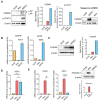Human Isogenic Cell Line Models for Neutrophils and Myeloid-Derived Suppressor Cells
- PMID: 33081041
- PMCID: PMC7590135
- DOI: 10.3390/ijms21207709
Human Isogenic Cell Line Models for Neutrophils and Myeloid-Derived Suppressor Cells
Abstract
Neutrophils with immunosuppressive activity are polymorphonuclear myeloid-derived suppressor cells (MDSCs) and may contribute to the resistance to cancer immunotherapy. A major gap for understanding and targeting these cells is the paucity of cell line models with cardinal features of human immunosuppressive neutrophils and their normal counterparts, especially in an isogenic manner. To address this issue, we employ the human promyelocytic cell line HL60 and use DMSO and cytokines (granulocyte macrophage-colony stimulating factor (GM-CSF) and interleukin 6 (IL6)) to induce the formation of either neutrophils or MDSCs. The induced MDSCs are CD11b+ CD33+ HLA-DR-/low and are heterogeneous for CD15 and CD14 expression. The induced MDSCs abrogate IL2 production and activation-induced cell death of the human T cell line Jurkat stimulated by CD3/CD28 antibodies, whereas the induced neutrophils enhance IL2 production from Jurkat cells. The induced MDSCs upregulate the expression of C/EBPβ, STAT3, VEGFR1, FATP2 and S100A8. Lastly, the immunosuppressive activity of the induced MDSCs is inhibited by all-trans retinoic acid and STAT3 inhibitor BP-1-102 through cellular differentiation and dedifferentiation mechanisms, respectively. Together, our study establishes a human isogenic cell line system for neutrophils and MDSCs and this system is expected to facilitate future studies on the biology and therapeutics of human immunosuppressive neutrophils.
Keywords: GM-CSF; HL60; IL6; Jurkat; PMN-MDSC; STAT3 inhibitor; all-trans retinoic acid; myeloid-derived suppressor cell; neutrophil.
Conflict of interest statement
The authors declare no conflict of interest.
Figures





Similar articles
-
Decidua-derived granulocyte macrophage colony-stimulating factor induces polymorphonuclear myeloid-derived suppressor cells from circulating CD15+ neutrophils.Hum Reprod. 2020 Dec 1;35(12):2677-2691. doi: 10.1093/humrep/deaa217. Hum Reprod. 2020. PMID: 33067638
-
Regulation of ROS in myeloid-derived suppressor cells through targeting fatty acid transport protein 2 enhanced anti-PD-L1 tumor immunotherapy.Cell Immunol. 2021 Apr;362:104286. doi: 10.1016/j.cellimm.2021.104286. Epub 2021 Jan 19. Cell Immunol. 2021. PMID: 33524739
-
The impact of cytokines and tumour-conditioned medium on the properties of murine in vitro generated myeloid-derived suppressor cells.Scand J Immunol. 2025 Feb;101(2):e70001. doi: 10.1111/sji.70001. Scand J Immunol. 2025. PMID: 39865924
-
Myeloid derived suppressor cells-An overview of combat strategies to increase immunotherapy efficacy.Oncoimmunology. 2015 Feb 3;4(1):e954829. doi: 10.4161/21624011.2014.954829. eCollection 2015 Jan. Oncoimmunology. 2015. PMID: 25949858 Free PMC article. Review.
-
Phenotype, development, and biological function of myeloid-derived suppressor cells.Oncoimmunology. 2015 Oct 14;5(2):e1004983. doi: 10.1080/2162402X.2015.1004983. eCollection 2016 Feb. Oncoimmunology. 2015. PMID: 27057424 Free PMC article. Review.
Cited by
-
Enhancing immune checkpoint blockade therapy of genitourinary malignancies by co-targeting PMN-MDSCs.Biochim Biophys Acta Rev Cancer. 2022 May;1877(3):188702. doi: 10.1016/j.bbcan.2022.188702. Epub 2022 Feb 25. Biochim Biophys Acta Rev Cancer. 2022. PMID: 35227829 Free PMC article.
-
The role of myeloid derived suppressor cells in musculoskeletal disorders.Front Immunol. 2023 Mar 3;14:1139683. doi: 10.3389/fimmu.2023.1139683. eCollection 2023. Front Immunol. 2023. PMID: 36936946 Free PMC article. Review.
-
GSDME deficiency leads to the aggravation of UVB-induced skin inflammation through enhancing recruitment and activation of neutrophils.Cell Death Dis. 2022 Oct 1;13(10):841. doi: 10.1038/s41419-022-05276-9. Cell Death Dis. 2022. PMID: 36182937 Free PMC article.
-
Studying Neutrophil Function in vitro: Cell Models and Environmental Factors.J Inflamm Res. 2021 Jan 20;14:141-162. doi: 10.2147/JIR.S284941. eCollection 2021. J Inflamm Res. 2021. PMID: 33505167 Free PMC article. Review.
-
Protein Signature Differentiating Neutrophils and Myeloid-Derived Suppressor Cells Determined Using a Human Isogenic Cell Line Model and Protein Profiling.Cells. 2024 May 7;13(10):795. doi: 10.3390/cells13100795. Cells. 2024. PMID: 38786019 Free PMC article.
References
MeSH terms
Substances
Grants and funding
LinkOut - more resources
Full Text Sources
Research Materials
Miscellaneous

